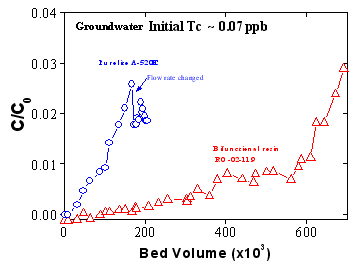Treatment of Pertechnetate (TcO4-)-Contaminated Groundwater

|
This study evaluated a new class of bifunctional anion-exchange resins developed at the Oak Ridge National Laboratory for removing pertechnetate (TcO4-) from contaminated groundwater. Both laboratory-column and field flow-through experiments were performed, and results indicated that superior performance of the bifunctional resins has been achieved through the use of two quaternary ammonium groups, one having long chains (trihexylamine) for higher selectivity for poorly hydrated large anions and one having shorter chains (triethylamine) for enhanced kinetics and exchange capacity. Field results indicated that the bifunctional resin performed much better than one of the best commercial monofunctional anion-exchange resins (e.g., Puroliteâ A-520E) with respect to the removal of TcO4- from contaminated groundwater (with improved selectivity and sorption kinetics). Less than 3% of TcO4- breakthrough was observed after ~700,000 bed volumes (BV) of contaminated groundwater had been treated by the bifunctional resin column at the U.S. Department of Energy's Paducah Gaseous Diffusion Plant site. The results demonstrate that the new resin is particularly effective in removing low levels of TcO4- (e.g., at influent concentration of ~0.07 mg/L or ~0.7 nmol/L Tc), and a cost saving may be realized by using the bifunctional resins for the treatment of large quantities of contaminated groundwater because of its increased selectivity, treatment efficiency, and longevity. The new resin may also be applied for the efficient treatment of other poorly hydrated large anions such as perchlorate (ClO4-) from contaminated groundwater or surface water.
Related Publications
-
Gu, B.; Ruan, C. 2007. Determination of technetium and its speciation by surface enhanced Raman spectroscopy. Anal. Chem, 79, 2341-2345.
-
B. Gu, G. M. Brown, P. V. Bonnesen, L. Liang, B. A. Moyer, R. Ober, S. D. Alexandratos. 2000. Development of Novel Bifunctional Anion-Exchange Resins with Improved Selectivity for Pertechnetate: Column Breakthrough and Field Studies. Environ. Sci. Technol. 34:1075-1080.
-
B. Gu, K. E. Dowlen, L. Liang, and J. L. Clausen. 1996. Efficient separation and recovery of technetium-99 from contaminated groundwater. Separations Technol. 6:123-132.
-
G. M. Brown, P. V. Bonnesen, B. A. Moyer, B. Gu, S. D. Alexandratos, V. Patel, and R. Ober. 2000. Chapter 13. The design of selective resins for the removal of pertechnetate and perchlorate from groundwater . In Perchlorate in the environment, E. T. Urbansky (ed). Plemner, New York. pp 155-164.
-
L. Liang, B. Gu, and X. Yin. 1996. Removal of technetium-99 from contaminated groundwater with sorbents and reductive materials. Separations Technol. 6:111-122.
-
G. M. Brown, P. V. Bonnesen, B. A. Moyer, B. Gu, S. D. Alexandratos, V. Patel, and R. Ober. 1999. The design of selective resins for the removal of pertechnetate and perchlorate from groundwater. 218th ACS National Meeting, New Orleans, Louisiana. August 22-26, 1999.
-
B. Gu, L. Liang, G.M. Brown, P.V. Bonnesen, B.A. Moyer, S.D. Alexandratos, and Ober R. 1998. A field trial novel bifunctional resins for removing pertechnetate (TcO4-) from contaminated groundwater. ORNL/TM-13593. Oak Ridge National Laboratory, Oak Ridge, TN.
-
B. Gu and K. E. Dowlen. 1996. An investigation of groundwater organics, soil minerals, and activated carbon on the complexation, adsorption, and separation of technetium-99. ORNL/TM-13154. Environ. Sci. Div., Oak Ridge National Laboratory, Oak Ridge, TN.
-
B. Gu and R. K. Schulz. 1991. Anion retention in soil: possible application to reduce migration of buried technetium and iodine. NUREG/CR-5464. U. S. Nuclear Regulatory Commission, Washington, DC 20555.
Baohua Gu (gub1@ornl.gov, 865-574-7286)

